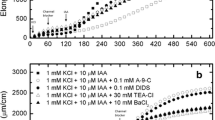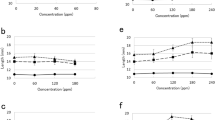Abstract
The dose-response curves for IAA and 4-Cl-IAA-induced growth of Zea mays L. coleoptile segments were studied as a function of time. Moreover, some characteristic growth parameters for both auxins were compared. The dose-response curve of growth rate measured after IAA or 4-Cl-IAA application was bell-shaped in all experiments. The optimum concentration was 10−6 M for 4-Cl-IAA and was found not to depend on the time of the growth measurement. However, in the case of IAA the optimum shifted from 10−6 M at the time of maximal growth rate to 10−5 M or even 10−4 M, when growth measured 3–4 hours after auxin application was analysed. The relative activity of 4-Cl-IAA-induced growth rate (as compared to IAA) increased significantly with increasing time from addition of this auxin to the medium. For both auxins the time needed to reach the maximal growth rate was clearly related to their concentrations. These data provided further evidence that 4-Cl-IAA is much more active auxin than IAA and can also suggest that IAA is more rapidly metabolized in comparison to 4-Cl-IAA.
Similar content being viewed by others
Abbreviations
- IAA:
-
3-indoleacetic acid
- 4-Cl-IAA:
-
4-chloroindoleacetic acid
References
Ahmad A., Anderson A.S., and Engvild K. 1987. Rooting, growth and ethylene evolution of pea cuttings in response to chloroindole auxins. Physiol. Plant., 69: 137–140.
Barr R., Böttger M., and Crane F.L. 1991. The effect of chloro-derivatives of indole acetic acid on plasma membrane electron transport and proton excretion. Proc. Indiana Acad. Sci., 99: 129–136.
Böttger M., Engvild K.C., and Soll H. 1978. Growth of Avena coleoptiles and pH drop of protoplast suspensions induced by chlorinated indoleacetic acids. Planta, 140: 89–92.
Cleland R.E. 1972. The dosage-response curve for auxin-induced cell elongation. A re-evaluation. Planta, 104: 1–9.
Engvild K.C. 1996. Herbicidal activity of 4-chloro-indoleacetic acid and other auxins on pea, barley and mustard. Physiol. Plant., 96: 333–337.
Fischer C., Lüthen H., Böttger M., and Hertel R. 1992. Initial transient growth inhibition in maize coleoptiles following auxin application. J. Plant Physiol., 141: 88–92.
Gandar J.C., Nitsch C. 1967. Isolement de l’ester methylique d’un acide chloro-3-indolylacetiqe a partir de graines immatures de pois Pisum sativum L. C.R. Acad. Sci. (Paris). Ser. D., 265: 1795–1798.
Hertel R. 1994. A critical review on proposed hormone action: the example of auxin. In: Smith C.J. et al. eds. Biochemical mechanisms involved in plant growth regulation. Oxford: Clarendon Press, 1–15.
Hertel R. 1995. Auxin binding protein 1 is a red herring. J. Exp. Bot., 46: 461–462.
Huizen R., Ozga J.A., Reinecke D.M., Twitchin B., and Mander L.N. 1995. Seed and 4-chloroindole-3-acetic acid regulation of gibberellin metabolism in pea pericarp. Plant Physiol., 109: 1213–1217.
Karcz W., Stolarek J., Pietruszka M., and Małkowski E. 1990. The dose-response curves for IAA induced elongation growth and acidification of the incubation medium of Zea mays coleoptile segments. Physiol. Plant., 80: 257–261.
Karcz W., Burdach Z. 1995. Effect of temperature on the IAA, 4-Cl-IAA and FC-induced growth and H+-extrusion in Zea mays L. coleoptile segments. In: 10th International Workshop on Plant Membrane Biology. Regensburg, August 6–11, Abst., S 16.
Lüthen H., Böttger M. 1988. Kinetics of proton secretion and growth in maize roots: action of various plant growth effectors. Plant Science, 54: 37–43.
Lüthen H., Böttger M. 1991. A high tech low cost auxanometer for high resolution determination of elongation rates in six simultaneous experimental setups. Mitt. Inst. Allg. Bot. Hamburg, 24.
Lüthen H., Böttger M. 1993. Induction of elongation in maize coleoptiles by hexachloroiridate and its interrelation with auxin and fusicoccin action. Physiol. Plant., 89: 77–86.
Marumo S., Hattori H., Abe H., Munakata K. 1968. Isolation of 4-chloroindolyl-3-acetic acid from immature seeds of Pisum sativum. Nature, 219: 959–960.
Marumo S., Hattori H., and Yamamoto A. 1974. Biological activity of 4-chloroindolyl-3-acetic acid. In: Plant Growth Substances. Hirokawa Publishing Company Inc., Tokyo, 419–428.
Macdowall F.D.H., Sirois J.C. 1977. Importance of time after excision and of pH on the kinetics of response of wheat coleoptile segments to added indoleacetic acid. Plant Physiol., 59: 405–410.
Nissl D., and Zenk M.H. 1969. Evidence against induction of protein synthesis during auxin-induced initial elongation of Avena coleoptile. Planta, 89: 323–341.
Pless T., Böttger M., Hedden P., and Grabe J. 1984. Occurrence of 4-Cl-indoleacetic acid in broad beans and correlation of its levels with seed development. Plant Physiol., 74: 320–323.
Stotz H.U., and Hertel R. 1994. Reevaluation of the role of auxin binding site II. J. Plant Regul., 13: 79–85.
Reinecke D.M., Ozga J.A., Magnus V. 1995. Effect of halogen substitution of indole-3-acetic acid on biological activity in pea fruit. Phytochemistry, 40: 1361–1366.
Rescher U., Walther A., Schiebl C., and Klämbt D. 1996. In vitro binding affinities of 4-chloro-, 2-methyl-, 4-methyl-, and 4-ethylindoleacetic acid to auxin-binding protein 1 (ABP1) correlate with their growth-stimulating activities. J. Plant Growth Regul., 15: 1–3.
Tietze-Hass E., and Dörffling K. 1977. Initial phases of indoleacetic acid induced growth in coleoptiles segments of Avena sativa L. Planta, 135: 149–154.
Venis M.J. 1995. Auxin binding protein 1 is a red herring? Oh no it isn’t! J. Exp. Bot., 463–465.
Vesper M.J., and Evans M.L. 1978. Time-dependent changes in the auxin sensitivity of coleoptile segments. Plant Physiol., 61: 204–208.
Author information
Authors and Affiliations
Rights and permissions
About this article
Cite this article
Karcz, W., Lüthen, H. & Böttger, M. Effect of IAA and 4-Cl-IAA on growth rate in maize coleoptile segments. Acta Physiol Plant 21, 133–139 (1999). https://doi.org/10.1007/s11738-999-0067-z
Received:
Accepted:
Issue Date:
DOI: https://doi.org/10.1007/s11738-999-0067-z




